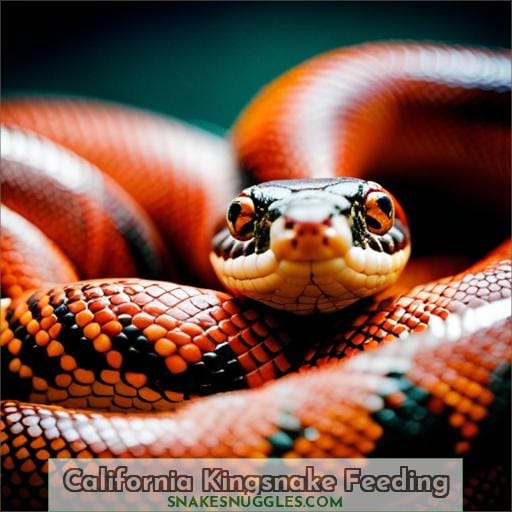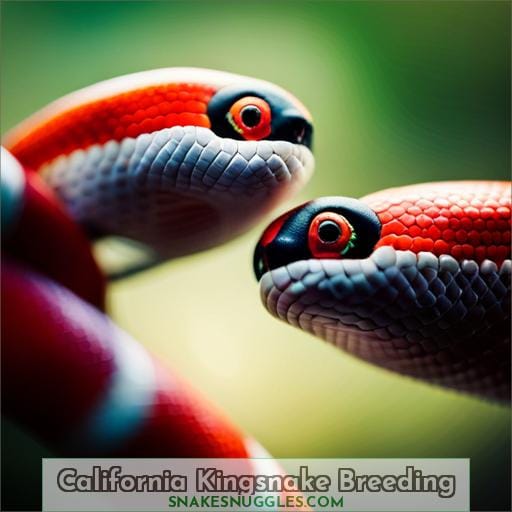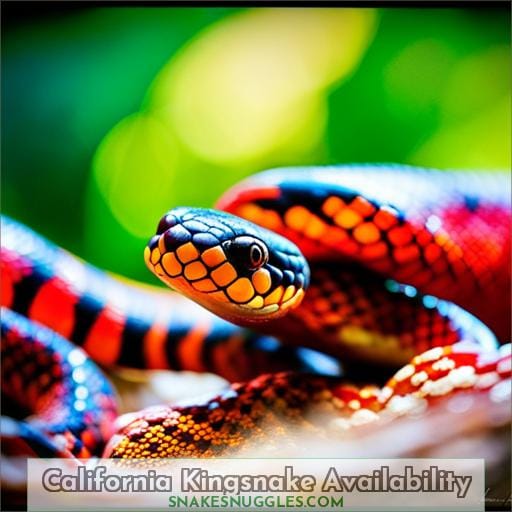This site is supported by our readers. We may earn a commission, at no cost to you, if you purchase through links.
 Breeding king snakes carries real risks if you improperly house pairs. However, with care around introducing and monitoring snakes, separating them promptly after mating, and properly incubating eggs, you may find it rewarding.
Breeding king snakes carries real risks if you improperly house pairs. However, with care around introducing and monitoring snakes, separating them promptly after mating, and properly incubating eggs, you may find it rewarding.
Mind enclosure conditions like substrate, decoration, and ample floor space as you plan. Even solitary kings have particular needs to stay healthy, including specific heating, humidity, and hides.
Table Of Contents
- Key Takeaways
- Can King Snakes Cohabitate?
- California Kingsnake Housing
- California Kingsnake Feeding
- California Kingsnake Temperature and Lighting
- California Kingsnake Health and Handling
- California Kingsnake Breeding
- California Kingsnake Availability
- California Kingsnake Size and Life Span
- California Kingsnake Substrate and Enclosure
- California Kingsnake Water Requirements
- Frequently Asked Questions (FAQs)
- Do king snakes get stressed when housed together?
- How often should cohabitated king snakes be monitored for signs of aggression or cannibalism?
- Is there a specific king snake size ratio that should be followed when cohabitating king snakes?
- Can hatchling or juvenile king snakes be safely cohabitated?
- What are some techniques to reduce aggression when attempting to cohabitate king snakes?
- Conclusion
Key Takeaways
- Monitor cohabitated king snakes closely for signs of aggression or stress.
- Avoid housing multiple king snakes together due to risks of aggression and cannibalism.
- When choosing the right king snakes to cohabitate, research their behavior and temperament carefully, and consider the importance of escape-proof design. Adjust enclosure sizes appropriately to accommodate multiple king snakes if cohabitating.
- Carefully introduce king snakes prior to cohabitation and separate after breeding.
Can King Snakes Cohabitate?

When it comes to housing multiple king snakes together, you shouldn’t do it.
They’re likely to attack and possibly kill one another regardless of sex, size, or familial relations.
King snakes have strong cannibalistic tendencies and will view other snakes as prey, even members of their own species or relatives.
They’re territorial solitary snakes that become stressed when housed together due to competition for resources like food, water, heat, and hiding spots.
Cohabitation makes it difficult to monitor each snake’s health and wellbeing.
Breeding presents additional problems since king snakes may attempt to eat potential mates.
These combative behaviors persist no matter how large the enclosure.
Though some snake species tolerate cohabitation when provided proper environmental enrichment, the aggressive nature and feeding requirements of king snakes mean they should always be housed separately.
California Kingsnake Housing
For proper housing of a California kingsnake, you’ll want to provide an adequately sized enclosure with appropriate substrates, hides, and access to clean water.
When housing California kingsnakes, a key consideration is evaluating compatibility and territorial behaviors through careful behavioral observations.
Given their predatory instincts, housing multiple kingsnakes together poses breeding challenges and risks aggressive territorial disputes.
Carefully assess each snake’s temperament before attempting any cohabitation.
Provide an enclosure at least 36 x 18 x 12 for an adult, with substrates like aspen shavings or cypress mulch that enable burrowing.
Include hides throughout, allowing the snake to feel secure while thermoregulating.
Continuously monitor all cohabitated snakes for signs of aggression or stress.
Adjust enclosure sizes appropriately depending on kingsnakes housed together.
Supply fresh, dechlorinated water at all times in a sturdy bowl.
California Kingsnake Feeding
California kingsnakes are ambush predators that use sharp teeth to kill prey before swallowing it whole.
They’ve evolved reproductive behaviors to ensure survival of the species, though cohabitation isn’t recommended for most snake species due to their territoriality.
When setting up a terrarium, provide anchors for perches to allow ambush tactics and a thermal gradient with a 90-95°F basking area.
While kingsnakes do eat other snakes, cohabitation can lead to unnecessary aggression and even cannibalism between males or hungry females.
You’ll want to feed your California kingsnake an appropriately sized mouse or rat once every 5-7 days while it’s young, moving to 7-10 days for an adult.
Select prey items that are no thicker than the widest part of the snake’s body to prevent regurgitation or impaction issues.
- Live mice or rats
- Frozen-thawed rodents
- Small birds
- Small lizards
California Kingsnake Temperature and Lighting
You must provide your California kingsnake with a temperature gradient ranging from 75°F to 88°F in its enclosure to allow for proper thermoregulation.
Use undertank heating pads or overhead ceramic heat emitters paired with lighting techniques to establish this temperature range.
Maintaining correct ambient temperatures and a sufficiently warm basking area enables the snake to regulate its body temperature by moving within the habitat as needed.
Monitor conditions with thermometers on both cool and warm ends.
Adjust settings seasonally.
Ensure the daytime photoperiod offers 10-12 hours of light using UVB emitting full spectrum reptile bulbs.
Proper temperature, lighting conditions, and seasonal adjustments promote healthy behavior.
While some snake species tolerate cohabitation under certain conditions, kingsnakes should be housed separately due to their aggressive nature.
California Kingsnake Health and Handling
When caring for your kingsnake, you’ll need to:
- Regularly check its health and properly handle it to prevent stress or injury.
- Look for signs of illness like wheezing, mucus in the mouth, or skin lesions.
- Quarantine any sick snakes.
Healthy kingsnakes should be:
- Alert with clear eyes
- No nasal discharge
- Smooth skin
Practice safe handling techniques like:
- Supporting the snake’s body
- Not restraining too tightly
- Avoiding tail pulling
- Keeping handling sessions brief
Aggressive behavior like:
- Mouth gaping
- Hissing
- Striking
- Rigid body postures
Indicates a stressed snake.
Adjust elements of the terrarium like:
- Temperatures
- Humidity level
- Hides
- Substrate
If health or behavior issues persist.
Recheck adjusted husbandry and veterinary care if problems continue.
California Kingsnake Breeding
When breeding California Kingsnakes, you’ll need to:
- Carefully introduce the breeding pair.
- Closely monitor mating.
- Separate the snakes after breeding to prevent cannibalism.
- Provide proper conditions for the female to lay and incubate the eggs.
These key steps are critical for safely and successfully breeding these snakes while avoiding potential harm from their aggressive and cannibalistic tendencies.
Now let’s delve into the specifics around:
- Introducing the snakes
- Monitoring mating
- Separating after breeding
- Egg laying and incubation
Introducing the Snakes
Before pairing them, ascertain that both your male and female California kingsnake appear healthy and well-fed.
Observe mating behaviors.
Separate if aggression occurs.
Reintroduce when receptive.
Monitoring Mating
During mating, keep watch over the snakes to prevent any injuries.
Observe their behavior patterns and reproductive activity.
Monitor environmental conditions to support breeding success.
| Observation Techniques | Behavior Patterns |
|---|---|
| Direct observation | Courtship rituals |
| Video recording | Copulation |
| Temperature/humidity gauges | Aggression |
Separating After Breeding
You’ll need to separate the snake pair once mating’s complete to prevent cannibalistic attacks.
Monitor the snakes for aggressive behavior.
Remove the male as soon as mating concludes.
Provide the female with a safe, private nesting area.
Egg Laying and Incubation
You’ll need to provide your female with an appropriate egg-laying enclosure once she’s gravid.
California kingsnakes typically lay 3-24 leathery-shelled eggs roughly 30 days after breeding.
Monitor maternal care, temperature control, and hatching to ensure breeding success.
Incubation Temperature: 80-85°F
Incubation Humidity: 50-60%
Hatching Timeframe: 55-65 days
Clutch Size: 3-24 eggs
California Kingsnake Availability
You can find California kingsnakes widely available from reputable breeders and some pet stores.
They’re bred prolifically in captivity, so there’s a good supply available.
You can often find California kingsnakes for sale at reptile expos and shows.
There are online breeders and sellers that will ship California kingsnakes to you.
Some things to keep in mind when acquiring a California kingsnake:
- Purchase captive bred specimens, not wild caught. This reduces impact on native populations.
- Inspect the snake’s health before purchasing. Look for signs of disease or parasites.
- Understand proper husbandry needs for lifespan up to 20 years. Provide adequate enclosure size and temperature gradient.
California Kingsnake Size and Life Span
You’re looking at a 3- to 5-foot snake with a potential lifespan of over 20 years.
California kingsnakes typically reach adult lengths of 3 to 4 feet, though some specimens may grow larger than 5 feet.
Growth patterns and maximum size can vary depending on subspecies, locality, genetics, prey availability, and husbandry.
Specimens from coastal locales often remain smaller than inland counterparts.
Well-fed captive snakes generally grow quicker and larger than wild ones.
Kingsnakes from arid regions are usually smaller than those from more temperate areas with higher rainfall and more abundant prey.
Lifespan is similarly impacted by factors like climate, food supply, and care.
Providing proper heating, humidity, diet, and habitat enables captive kingsnakes to achieve long, healthy lives.
California Kingsnake Substrate and Enclosure
One should provide California kingsnakes with an appropriate bedding options and enclosure to meet their needs
.
Use aspen shavings, cypress mulch, or reptile carpet as substrate.
The enclosure should be escape-proof, with a secure top.
Provide a gradient of temperatures and humidity levels.
The enclosure should allow for a temperature gradient from 75-85°F to a 90-95°F basking area.
Place branches, hides, and artificial plants to provide cover and climbing opportunities.
Spot clean waste daily, and change substrate completely every 2-3 weeks.
Provide a large water bowl, but high humidity isn’t essential.
Decor should be simpler for snakes housed together to prevent territorial disputes.
Proper housing is key for health and to discourage aggression between cohabitating kingsnakes.
California Kingsnake Water Requirements
Your California kingsnake’s water requirements include:
- Providing fresh, clean water at all times in a bowl large enough for soaking.
- A water bowl with a diameter wider than the thickest part of your kingsnake’s body allows full submersion for proper hydration and shedding.
Maintain moderate humidity between 40-60% inside the enclosure:
- Use a hygrometer to monitor humidity and adjust as needed by misting or adjusting ventilation.
- Substrates like cypress mulch help hold humidity while coconut husk and aspen offer less.
Offer frequent baths during shedding to aid removal of old skin.
Dehydration causes skin sticking, complicating sheds.
Ensure adequate access to drinking and soaking water to support your kingsnake’s health and prevent issues like poor sheds, dehydration, and constipation.
Frequently Asked Questions (FAQs)
Do king snakes get stressed when housed together?
Generally, yes, king snakes get stressed when housed together.
As solitary reptiles, king snakes are intolerant of cagemates and often attack or attempt to eat others sharing their enclosure.
It is better to keep king snakes alone in a properly sized habitat.
How often should cohabitated king snakes be monitored for signs of aggression or cannibalism?
Monitor cohabitated king snakes daily, as they often attack each other.
Stay vigilant for aggressive behaviors like hissing, striking, or constricting, which precede cannibalism.
Isolate snakes showing aggression immediately.
Despite their solitary natures, constant vigilance can enable temporary cohabitation.
Is there a specific king snake size ratio that should be followed when cohabitating king snakes?
No, there’s no safe king snake size ratio for cohabitation.
Even similarly sized king snakes may attack each other due to their competitive nature.
Monitor any cohabited king snakes closely as cannibalism can occur unpredictably.
Can hatchling or juvenile king snakes be safely cohabitated?
No, hatchling or juvenile king snakes shouldn’t be cohabitated regardless of size ratios.
Their aggressive and cannibalistic nature emerges early, so housing them together risks attacks or fatalities.
Provide each juvenile king snake its own secure enclosure.
What are some techniques to reduce aggression when attempting to cohabitate king snakes?
Provide plenty of space and hiding areas.
Monitor closely for signs of aggression or stress, and separate immediately if observed.
Try introducing juveniles at a young age before territorial behavior develops.
However, cohabitation is still risky with cannibalistic species like king snakes.
Conclusion
All in all, cohabitation may not suit the stereotypical solitary nature of king snakes.
Yet, with attentive preparation, you can safely house and breed pairs.
Mind ample space, hides, heating, and humidity so each snake stays stress-free.
Monitor mating closely, then separate the snakes.
Like Pandora unleashing both hope and hardship from her box, breeding kings brings rewards and risks.
Attend to their specialized needs, and you’ll find your effort repaid in healthy eggs.















